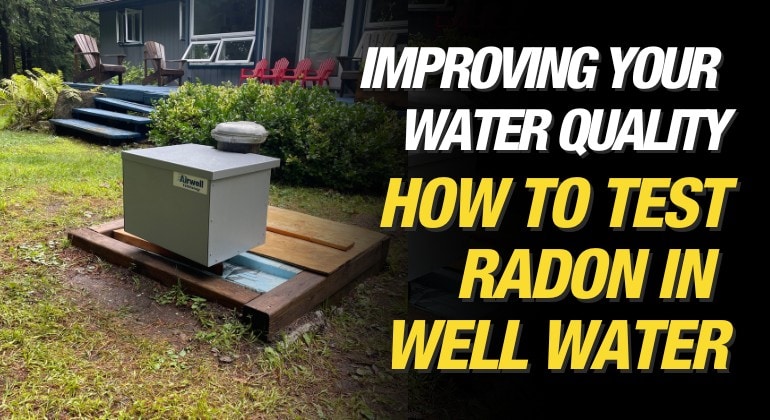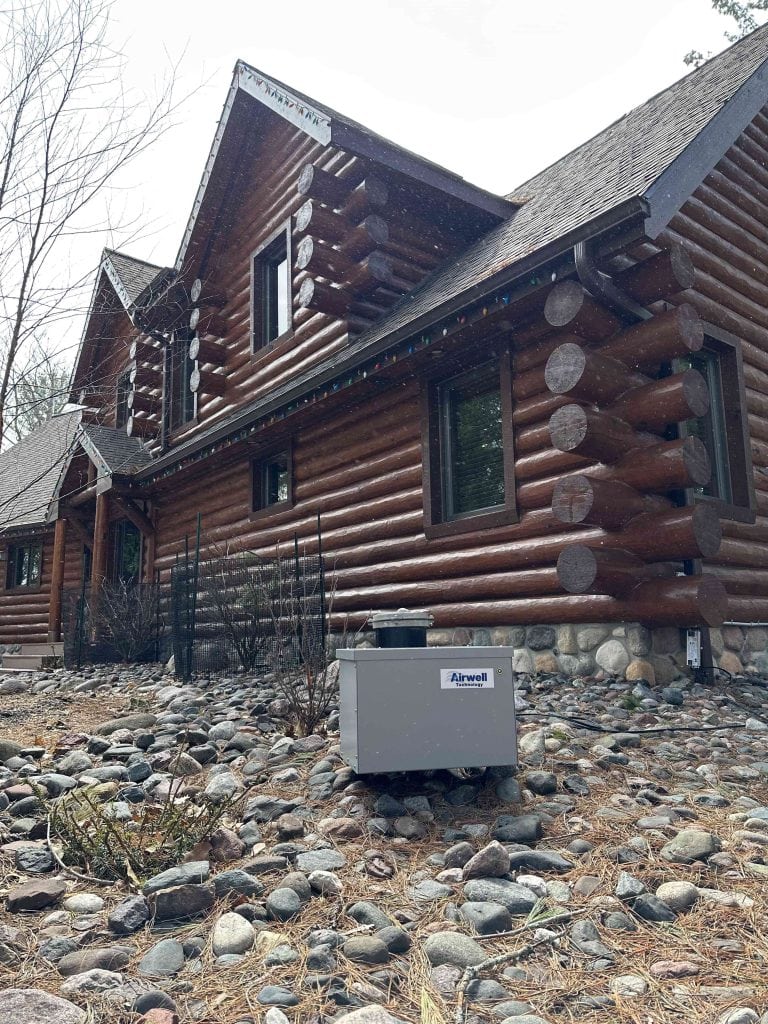Heat Pump vs Conventional AC (Air Conditioner): Which is Better for Cooling? Summer is here and it’s bringing the heat. But I can’t complain because I love the summer weather,...

How to Test Radon in Well Water
By Mike Holmes
Mike’s Advice / Home Safety & Maintenance
Friday, August 11th, 2023 @ 4:00pm
Is Radon in Well Water Dangerous?
You’ve seen me speak about Radon a lot over the years. Why? Because it is a very dangerous gas known to be the leading source of lung cancer in non-smokers. It’s shocking and many homeowners don’t know about it or how to go about mitigating radon levels in your home. Not only that but I recently learned that radon can exist in your water source too particularly if you rely on well water —like me.
Thankfully there is a solution out there to help mitigate it so let’s take a closer look at that.
What is Radon Gas?
For those who don’t know what radon is, radon gas is colourless, odourless, and tasteless gas that can be anywhere in the air inside your home. It comes from the breakdown of uranium in soils, rocks, and water. In enclosed spaces like residential and commercial properties, it can accumulate to dangerously high levels.
Radon exists naturally in soil and rock, so it makes sense it could be found in your water supply.
READ MORE
How Does Radon Get into Well Water?
Since your well is buried in the ground, radon gas may naturally dissolve into the well water that enters your home. You drink it, bathe in it, wash your dishes and clothing in it, etc.
Not to mention, because radon is relatively insoluble in water, just opening your tap releases radon into the indoor air and contributes to the total indoor-airborne radon concentrations.
The presence of radon in water can be as unpredictable as that of radon in your home, and levels in wells, even nearby, might vary considerably. That is why I advise any homeowner who relies on well water to get their water tested.
“While most radon-related deaths are due to radon gas accumulated in houses from seepage through cracks in the foundation, 30 to 1,800 deaths per year are attributed to radon from household water. High levels of dissolved radon are found in the groundwater in some areas flowing through granite or granite sand and gravel formations.”
The Importance of Testing for Radon in Well Water
Exposure to radon in your water is a preventable health risk. All you have to do is test for it, and this can be done quickly and easily by taking a sample of your water.
If you are on a private well, the source of high indoor radon may be your water. When a high level of radon is detected, there are mitigation solutions available to keep you and your family safe.
Did You Know?
If you’ve got radon in the air of your house, and you are on a private well, 100% of the time you will have radon in your well water. That’s the case everywhere in North America. You should have your well water tested every year for bacteria and every two years for inorganic contaminants every two years.
Risks associated with exposure to Radon in Drinking Water
Though the risk is quite low according to Health Canada, radon found in water can off-gas through your shower, at the kitchen sink, or even in the laundry. Only 1–2% of the radon in the air is derived from drinking water. However, over the course of your lifetime, breathing radon raises your risk of developing lung cancer.
That’s not the worst of it. Drinking water that contains radon increases the chance of developing internal organ malignancies, particularly stomach cancer, as some radon levels remain in the water.
RELATED:
How To Test for Radon in Well Water
Professional Testing Services
If you are concerned about radon in your well it’s best to get your water tested by a water testing specialist or a DIY kit. Always ensure your kits are associated with a certified professional laboratory. Follow the instructions very carefully when using a DIY kit. I trust the folks at Radon Environmental, and would highly recommend using them for your well-water testing and DIY kits.
If you are concerned about radon in your home, it’s better to work with a trusted radon mitigation professional as they can assist you with your radon well-water testing.
Always ensure your kits are associated with a certified professional laboratory. Using the pros is always my best advice, and well-water testing is no different. I trust the folks at Radon Environmental, and would highly recommend using them for your well-water testing.
DIY Test Kits
While I don’t recommend it, there are many DIY Kits online, especially for radon water testing. However, it’s important to do your due diligence and purchase one from a reliable source that includes laboratory fees.
RELATED:
How to Take A Radon Water Sample
All that you need to test for radon in your water, is to collect a 500ml sample of your water with no air in the sample jar.
- Ensure the water sample is collected from a source in your home where the water coming out is not aerated, or treated by a water softener or reverse osmosis system. These systems agitate the water and will release some of the radon, so you won’t get a true reading on the radon levels in the water. The sample could also be taken from an outside hose bib or a drain off your cushion tank.
- Run the cold water for 10 – 20 minutes to ensure the water is from the bottom of the well and not the standing water in the pipes. This is also where the highest concentration of radon will be.
- Run the water very slowly down a board into a pail. The goal is to have a water sample with NO WATER BUBBLES. Once the pail is three-quarters full, then submerge a 500 ml mason jar under the water to fill it. Without any bubbles in the jar, and while still submerged put the lid on the jar.
- The sample jar needs to be sent the same day the sample is collected to a lab and must arrive within two days after collection.
Pro Tip:
The best day to collect your sample is a Monday or Tuesday, that way the test can be done by the week’s end.
Factors That Can Affect Test Results
To prevent contamination, faulty negative or faulty positive results you need to follow the instructions provided by the laboratory.
To obtain the most reliable test results ensure you don’t make the following mistakes:
- Take the water sample from an incorrect source
- Don’t allow the water to run sufficiently to clear the pipes
- Send in a water sample that has air bubbles
- Don’t ship the samples on the same day as the sample collection
Some radon water tests will also include a Uranium gross alpha and beta test. Similar to the radon water test, you will fill two larger bottles with water. Take special note that some test kit bottles may contain a preservative, like nitric acid. Nitric acid is highly corrosive so take special care not to allow the water to overflow when filling.
Again, always follow the instructions these bottles will have to be sent to a laboratory for testing. Or better yet, hire a professional to collect the water sample and do the test for you —that way you can guarantee it’s done correctly the first time and you get accurate results.
Interpreting Test Results
Epa standard action level is 4000PCI/l and each state adopts their own version of that. There is no action level or guidance for radon in water in Canada at this point.
What to Do if Your Radon Levels are High
If you have high levels of radon in your water there are two remediation methods available —aeration and GAC treatment. We use the Radon Environmental Corp Airwell aeration method.
Aeration Treatment
An aeration method mixes air with the water and then vents the air from the water before it enters your home. Most mitigation systems treat the water after it enters your house; the Airwell, on the other hand, mitigates the radon before it reaches your pipes.
More on how this works is below.
All the Airwell does is restore air access to the water. It’s easy, it’s natural, and if I’m using well water, I want this as part of my system.
GAC Treatment
The other common method is filtering the water through activated carbon, where radon attaches to the carbon and leaves the water free of radon. activated carbon systems also leave radioactive waste that needs to be disposed of making it dangerous.
The Airwell – Radon Mitigation Solution that Removes Radon from Well Water
Airwell is an aeration system that is installed directly into your private well. Lengths of pipes are fed down the well, going past the pump and to the bedrock, leaving about 5 feet from the bottom of the well.
Air, using a low-voltage compressor, is then injected into the piping, which will aerate the water. Creating a hydrodynamic pressure pulls the water from the bottom of the well, up through the pipe, and aerates it, radon will be released through the vents to the outside before the water enters the house.

The new radon Airwell system is 90% quieter.
Radon Environmental’s Airwell is a solution for all dissolved gases as well, not just radon. Airwell will mitigate sulphide, hydrogen sulphide, sulphur, methane, and with time, iron.
RELATED:
Advantages of the Airwell
- Airwell mitigates radon from the outside, installed at the wellhead
- The new airwell is 90% quieter which means you won’t know it’s there even with your windows open
- Airwell takes up no additional space in your home and is more convenient and effective than in-house aeration systems
- It’s virtually maintenance-free. Two air filters need cleaning with water, annually and a third filter needs to be changed annually at a cost of approx. $5.00
- Airwell has a higher radon reduction level compared to granular activated carbon methods and does not cause additional risk of radioactive waste in the home
- Not only does Airwell reduce radon levels by 92-99% it also reduces sulphur, methane, and certain types of iron levels as well.
READ MORE:
Why Is This Important?
Without testing Radon is completely undetectable. It is also the second leading cause of lung cancer in the world. Radon prefers to be a gas and once it is pumped from your well into the home through a tap, shower, dishwasher etc it is released back into a gas and inhaled by the occupants. This is why it is so important to get rid of the gasses before they enter the home with Airwell.

The new Airwell radon mitigation system is easy to install and maintain ensuring you have a safe radon free water supply.
I’ve been talking about the effects of radon gas for years. I want everyone to know that radon can get into your house through your water source. The good news is that it’s easy to remedy using a simple aeration system called Airwell. It’s straightforward to install, practically maintenance-free and will help protect you and your family from radon entering your home. Sounds great to me.
READ MORE:
How To Prevent Radon Gas In Your Home
7 FAQs about Radon and Radon Mitigation System DIY










